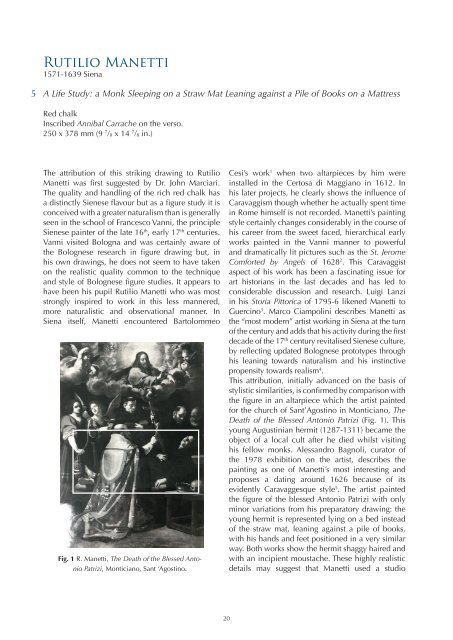Works on Paper 2019 - Jean Luc Baroni
- No tags were found...
Create successful ePaper yourself
Turn your PDF publications into a flip-book with our unique Google optimized e-Paper software.
Rutilio Manetti<br />
1571-1639 Siena<br />
5<br />
A Life Study: a M<strong>on</strong>k Sleeping <strong>on</strong> a Straw Mat Leaning against a Pile of Books <strong>on</strong> a Mattress<br />
Red chalk<br />
Inscribed Annibal Carrache <strong>on</strong> the verso.<br />
250 x 378 mm (9 7 /8 x 14 7 /8 in.)<br />
The attributi<strong>on</strong> of this striking drawing to Rutilio<br />
Manetti was first suggested by Dr. John Marciari.<br />
The quality and handling of the rich red chalk has<br />
a distinctly Sienese flavour but as a figure study it is<br />
c<strong>on</strong>ceived with a greater naturalism than is generally<br />
seen in the school of Francesco Vanni, the principle<br />
Sienese painter of the late 16 th , early 17 th centuries.<br />
Vanni visited Bologna and was certainly aware of<br />
the Bolognese research in figure drawing but, in<br />
his own drawings, he does not seem to have taken<br />
<strong>on</strong> the realistic quality comm<strong>on</strong> to the technique<br />
and style of Bolognese figure studies. It appears to<br />
have been his pupil Rutilio Manetti who was most<br />
str<strong>on</strong>gly inspired to work in this less mannered,<br />
more naturalistic and observati<strong>on</strong>al manner. In<br />
Siena itself, Manetti encountered Bartolommeo<br />
Fig. 1 R. Manetti, The Death of the Blessed Ant<strong>on</strong>io<br />
Patrizi, M<strong>on</strong>ticiano, Sant ‘Agostino.<br />
Cesi’s work 1 when two altarpieces by him were<br />
installed in the Certosa di Maggiano in 1612. In<br />
his later projects, he clearly shows the influence of<br />
Caravaggism though whether he actually spent time<br />
in Rome himself is not recorded. Manetti’s painting<br />
style certainly changes c<strong>on</strong>siderably in the course of<br />
his career from the sweet faced, hierarchical early<br />
works painted in the Vanni manner to powerful<br />
and dramatically lit pictures such as the St. Jerome<br />
Comforted by Angels of 1628 2 . This Caravaggist<br />
aspect of his work has been a fascinating issue for<br />
art historians in the last decades and has led to<br />
c<strong>on</strong>siderable discussi<strong>on</strong> and research. Luigi Lanzi<br />
in his Storia Pittorica of 1795-6 likened Manetti to<br />
Guercino 3 . Marco Ciampolini describes Manetti as<br />
the “most modern” artist working in Siena at the turn<br />
of the century and adds that his activity during the first<br />
decade of the 17 th century revitalised Sienese culture,<br />
by reflecting updated Bolognese prototypes through<br />
his leaning towards naturalism and his instinctive<br />
propensity towards realism 4 .<br />
This attributi<strong>on</strong>, initially advanced <strong>on</strong> the basis of<br />
stylistic similarities, is c<strong>on</strong>firmed by comparis<strong>on</strong> with<br />
the figure in an altarpiece which the artist painted<br />
for the church of Sant’Agostino in M<strong>on</strong>ticiano, The<br />
Death of the Blessed Ant<strong>on</strong>io Patrizi (Fig. 1). This<br />
young Augustinian hermit (1287-1311) became the<br />
object of a local cult after he died whilst visiting<br />
his fellow m<strong>on</strong>ks. Alessandro Bagnoli, curator of<br />
the 1978 exhibiti<strong>on</strong> <strong>on</strong> the artist, describes the<br />
painting as <strong>on</strong>e of Manetti’s most interesting and<br />
proposes a dating around 1626 because of its<br />
evidently Caravaggesque style 5 . The artist painted<br />
the figure of the blessed Ant<strong>on</strong>io Patrizi with <strong>on</strong>ly<br />
minor variati<strong>on</strong>s from his preparatory drawing: the<br />
young hermit is represented lying <strong>on</strong> a bed instead<br />
of the straw mat, leaning against a pile of books,<br />
with his hands and feet positi<strong>on</strong>ed in a very similar<br />
way. Both works show the hermit shaggy haired and<br />
with an incipient moustache. These highly realistic<br />
details may suggest that Manetti used a studio<br />
20
















